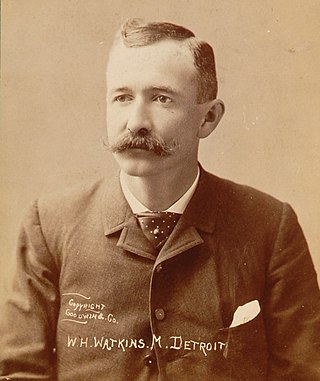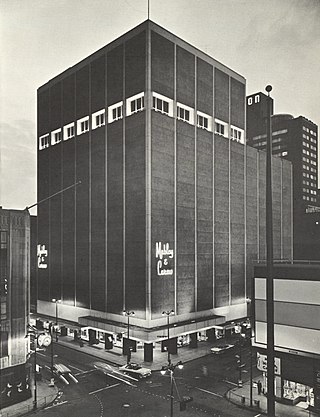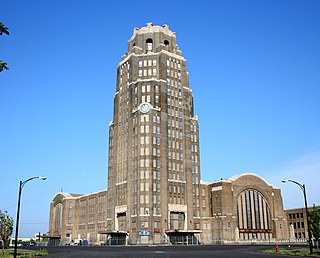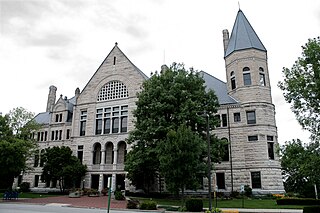Related Research Articles

Garrett Augustus Morgan Sr. was an American inventor, businessman, and community leader. His most notable inventions were a type of three-way traffic light, and a protective 'smoke hood' notably used in a 1916 tunnel construction disaster rescue. Morgan also discovered and developed a chemical hair-processing and straightening solution. He created a successful company called "G. A. Morgan Hair Refining Company" based on his hair product inventions along with a complete line of haircare products and became involved in the civic and political advancement of African Americans, especially in and around Cleveland, Ohio.

John Baptist Purcell was an American prelate of the Catholic Church. He served as Bishop of Cincinnati from 1833 to his death in 1883, and he was elevated to the rank of archbishop in 1850. He formed the basis of Father Ferrand, the Ohio-based "Irish by birth, French by ancestry" character in the prologue of Willa Cather's historical novel Death Comes for the Archbishop who goes to Rome asking for a bishop for New Mexico Territory.

Carew Tower is a 49-story, 574-foot (175 m) Art Deco building completed in 1930 in the heart of downtown Cincinnati, Ohio, United States, overlooking the Ohio River waterfront. The structure is the second-tallest building in the city, and it was added to the register of National Historic Landmarks on April 19, 1994. The tower is named after Joseph T. Carew, proprietor of the Mabley & Carew department store chain, which had previously operated in a building on the site.
F&R Lazarus & Company was a regional department store with its retail chain operating primarily in the U.S. Midwest, and based in Columbus, Ohio. For over 150 years, Lazarus was influential in the American retail industry, particularly during the early 20th century as a founding partner in Federated Department Stores, and continued until the nameplate was retired on March 6, 2005, in favor of Macy's.

William Henry Watkins, sometimes known as "Wattie," or "Watty," was a Canadian-born baseball player, manager, executive and team owner whose career in organized baseball spanned 47 years from 1876 to 1922.
Allied Stores was a department store chain in the United States. It was founded in the 1930s as part of a general consolidation in the retail sector by B. E. Puckett. See also Associated Dry Goods. It was the successor to Hahn's Department Stores, a holding company founded in 1928. In 1935 Hahn's was reorganized into Allied Stores.

Robert Seldon Duncanson was a 19th-century American landscapist of European and African ancestry. Inspired by famous American landscape artists like Thomas Cole, Duncanson created renowned landscape paintings and is considered a second generation Hudson River School artist. Duncanson spent the majority of his career in Cincinnati, Ohio and helped develop the Ohio River Valley landscape tradition. As a free black man in antebellum America, Duncanson engaged the abolitionist community in America and England to support and promote his work. Duncanson is considered the first African-American artist to be internationally known. He operated in the cultural circles of Cincinnati, Detroit, Montreal, and London. The primary art historical debate centered on Duncanson concerns the role that contemporary racial issues played in his work. Some art historians, like Joseph D. Ketner, believe that Duncanson used racial metaphors in his artwork, while others, like Margaret Rose Vendryes, discourage viewers from approaching his art with a racialized perspective.

The Elder-Beerman Stores Corp., commonly known as Elder-Beerman, was an American chain of department stores founded in 1883 and whose last stores closed in 2018. The chain, based primarily in the Midwestern United States, was composed of 31 stores in eight states at the time of its liquidation in 2018, and peaked around 2003 with 68 stores and $670 million in annual sales.
Samuel Hannaford was an American architect based in Cincinnati, Ohio. Some of the best known landmarks in the city, such as Music Hall and City Hall, were of his design. The bulk of Hannaford's work was done locally, over 300 buildings, but his residential designs appear through New England to the Midwest and the South.

Swifton Center was a shopping mall in Cincinnati, Ohio, United States. Opened in 1956 as the first mall in the Cincinnati area, it was initially an open-air complex featuring Rollman & Sons department store as the sole anchor store. This store was converted to Mabley & Carew in 1960, and again to Elder-Beerman in 1978. Other major tenants included Kroger, Liberal Market, G. C. Murphy, and S. S. Kresge. The mall had undergone a severe decline in tenancy by the early 1980s, resulting from the relocation of Kroger and deferred maintenance of the property.

Mabley & Carew was a prominent department store in Cincinnati, Ohio.
The H. & S. Pogue Company was a Cincinnati, Ohio based department store chain founded by two brothers, Henry and Samuel Pogue. They came from County Cavan, Northern Ireland, to Cincinnati and worked in their uncle's dry goods store. They later were able to buy him out and H. & S. Pogue Dry Goods Company was established in 1863 at 111 West Fifth Street. Brothers Thomas, Joseph, and William Pogue would eventually join the enterprise.

Alfred T. Fellheimer was an American architect. He began his career with Reed & Stem, where he was lead architect for Grand Central Terminal. Beginning in 1928, his firm Fellheimer & Wagner designed Cincinnati Union Terminal.

Christopher Richards Mabley (1836–1885) was the founder of a chain of department stores in United States. He was known as "The Merchant Prince".

The Detroit Financial District is a United States historic district in downtown Detroit, Michigan. The district was listed on the U.S. National Register of Historic Places on December 14, 2009, and was announced as the featured listing in the National Park Service's weekly list of December 24, 2009.

James W. McLaughlin was a Cincinnati, Ohio architect. He studied to be an architect working under famed James Keys Wilson. He fought in the American Civil War serving in the Union Army. During the late 19th century, he became a popular builder in Cincinnati. In 1870 he helped organize the Cincinnati chapter of the American Institute of Architects; that year, he was selected as a Fellow of the AIA, serving on its board.

Nicholas Longworth II was a lawyer from a prominent Cincinnati, Ohio, family who served on the Ohio Supreme Court.

George DeWitt Mason was an American architect who practiced in Detroit, Michigan, in the latter part of the 19th and early decades of the 20th centuries.

David May (1848–1927) was an American businessman and founder of the May Company department store.
Anderson Towne Center is a shopping mall in Cincinnati, Ohio, United States. Built in 1969 as Beechmont Mall, it originally included John Shillito Company (Shillito's) and Mabley & Carew as its major anchor stores, with Gold Circle joining in 1980. Each anchor store changed names twice during the original mall's history: Shillito's became Rike Kumler Co. (Rike's) and then Lazarus, Mabley & Carew became Elder-Beerman and then Parisian, while Gold Circle became Hills and then Kmart. Between 2002 and 2003, the center was demolished except for the Lazarus and Kmart buildings, and renamed to Anderson Towne Center. Following the conversion of Lazarus to Macy's at that point and the closure of Kmart in 2013, the center's present anchor stores are Macy's, Kroger, Sky Zone, and Crunch Fitness.